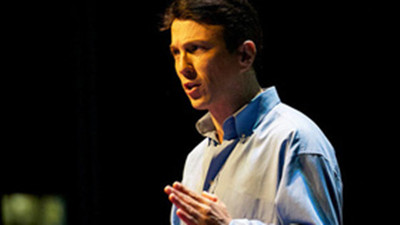A couple of years ago when I was attending the TED Conference in Long Beach,I met Harriet.
几年前我参加在长滩TED会议的时候,我遇到了哈里特。
We'd actually met online before not the way you're thinking.
实际上我们以前在网上遇到过,不是像你们想的那样。
We were actually introduced because we both knew Linda Avey,one of the founders of the first online personal genomic companies.
我们认识是因为我们都认识琳达埃维,首家私营基因公司创始人之一。
And because we shared our genetic information with Linda,she could see that Harriet and I shared a very rare type of mitochondrial DNA Haplotype K1a1b1a-K1a1b1a which meant that we were distantly related.
并且因为我们和琳达分享我们的基因信息,她知道哈里特和我都有一种很稀有的线粒体DNA-单模标本-这意味着我们是远亲。
We actually share the same genealogy with Ozzie the iceman.
实际上,我们都和冰人奥兹有亲缘关系。
So Ozzie, Harriet and me.
没错,奥兹,哈里特和我。
And being the current day, of course, we started our own Facebook group.
当然,如今我们有了自己的脸书网群组。
You're all welcome to join.
欢迎你们加入。
And when I met Harriet in person the next year at the TED Conference,she'd gone online and ordered our own happy Haplotype T-shirts.
当我在第二年TED会议遇见哈里特的时候,她在线订购了我们自己快乐的单模标本T恤衫。
Now why am I telling you this story,and what does this have to do with the future of health?
为什么我要告诉你们这个故事,这和未来健康有什么关系呢?

Well the way I met Harriet is actually an example of how leveraging cross-disciplinary,exponentially-growing technologies is affecting our future of health and wellness,from low-cost gene analysis to the ability to do powerful bio-informatics to the connection of the Internet and social networking.
实际上,我遇见哈里特的经过是一个很好的例子关于怎样利用学科交叉,指数增长的技术来影响我们将来的健康和保健事业,从低成本的基因分析到做强大生物信息学的能力到互联网和社会网络间的联系。
What I'd like to talk about today is understanding these exponential technologies.
我今天想谈的是理解这些指数增长的技术。
We often think linearly.
我们经常线性思考。
But if you think about it, if you have a lily pad and it just divided every single day two, four, eight, 16-2,4,8,16,in 15 days you have 32,000.
但是如果想像一下,如果你有一个睡莲叶子,它每天分裂一次,15天以后会有32000个叶子。
What do you think you have in a month? We're at a billion.
你认为1个月以后有多少?我们会有10亿。
So if we start to think exponentially,we can see how this is starting to affect all the technologies around us.
如果我们开始指数思考,我们会看到这会怎样影响到我们周围的技术。
And many of these technologies-speaking as a physician and innovator we can really start to leverage to impact the future of our own health and of health care,and to address many of the major challenges that we have in health care today,ranging from the really exponential costs to the aging population,the way we really don't use information very well today,the fragmentation of care and often the very difficult course of adoption of innovation.
许多技术-像一位物理学家和革新者所说的,我们能真正开始去利用它们,影响我们的未来健康和卫生保健,和谈论如今许多卫生保健面临的主要困难从巨额投入到高龄人群,我们没有真正很好地使用信息的现状,保健不均衡和常常面对困难棘手的经历,例如采用革新的历程。
And one of the major things we can do we've talked a bit about here today is moving the curve to the left.
今天我们谈到主要的事情之一是把曲线向左移。
We spend most of our money on the last 20 percent of life.
我们在生命的最后20%时间里花费了大部分的钱。
What if we could spend and incentivize positions in the health care system and our own self to move the curve to the left and improve our health,leveraging technology as well?
如果我们能够投资和激励岗位在健康保健系统和我们自身来向左移动这条曲线从而改善我们的健康,利用技术,会怎么样呢?
Now my favorite technology, example of exponential technology,we all have in our pocket.
我最喜爱的技术,指数技术的例子,在我们所有人的口袋里。
So if you think about it, these are really dramatically improving.
因此如果你想一下,你会发现这些技术真的显著提高了。
I mean this is the iPhone 4.
我指的是iPhone 4.
Imagine what the iPhone 8 will be able to do.
想像iPhone 8将能做什么。
Now, I've gained some insight into this.
现在,我有了一些见解。
I've been the track share for the medicine portion of a new institution called Singularity University based in Silicon Valley.
我追踪观察新成立的奇点大学的医学院,它座落在硅谷。
And we bring together every summer about 100 very talented students from around the world.
每个夏天我们召集世界各地100名非常有天赋的学生。
And we look at these exponential technologies from medicine, biotech,artificial intelligence, robotics, nanotechnology, space,and address how can we cross-train and leverage these to impact major unmet goals.
我们研究这些指数技术从医学,生物技术,人工智能,机器人技术,纳米技术,太空技术,来发现如何能多项培训并利用这些技术去影响重大未实现的目标。
We also have seven-day executive programs.
我们也有一个7天执行方案。
And coming up next month is actually Future Med,a program to help cross-train and leverage technologies into medicine.
接下来几个月的方案是未来医学,一个帮助多项培训和把技术应用到医学的项目。
Now I mentioned the phone.
现在我来说电话。
These mobile phones have over 20,000 different mobile apps available to the point where there's one out of the U.K.
这些手机有超过20000个不同的应用程序,从这点上说,有一个与众不同,
where you can pee on a little chip connected to your iPhone and check yourself for an STD.
那就是你可以通过在你的iPhone相连的一小块芯片上小便来自查是否有性传染病。
I don't know if I'd try that yet, but that's available.
我不知道我是否会这样做,但是它确实可用。
There are all other sorts of applications,merging your phone and diagnostics, for example,measuring your blood glucose on your iPhone and sending that,potentially, to your physician so they can better understand and you can better understand your blood sugars as a diabetic.
还有很多种应用,把你的电话和诊断联系在一起,例如,用你的iPhone测量你的血糖并可能把数据发给你的医生,使得他们和你都能更好得了解,你作为一个糖尿病人的血糖。
So let's see now how exponential technologies are taking health care.
现在让我们看看指数技术怎样进行健康保健。
Let's start with faster.
让我们从速度开始。
Well it's no secret that computers, through Moore's law,are speeding up faster and faster.
我们都知道,根据摩尔定律,计算机,运算速度越来越快。
We have the ability to do more powerful things with them.
因此我们能够做更强大的事情。
They're really approaching, in many cases surpassing,the ability of the human mind.
他们正在接近,在很多情况超越,人类思维的能力。
But where I think computational speed is most applicable is in that of imaging.
但是我认为计算速度最适用的地方是在于成像技术。
The ability now to look inside the body in real time with very high resolution is really becoming incredible.
这种技术能即时的观察身体内部用非常高的分辨率,真的很神奇。
And we're layering multiple technologies-PET scans, CT scans and molecular diagnostics to find and to seek things at different levels.
我们正在综合多种技术--PET扫描,CT扫描和分子诊断来发现和寻找不同层面的东西。
Here you're going to see the very highest resolution MRI scan done today,reconstructed of Marc Hodosh, the curator of TEDMED.
今天在这里你们将会看到非常高分辨率的MRI扫描,它是由TEDMED的主持者马克霍道什重建的。













